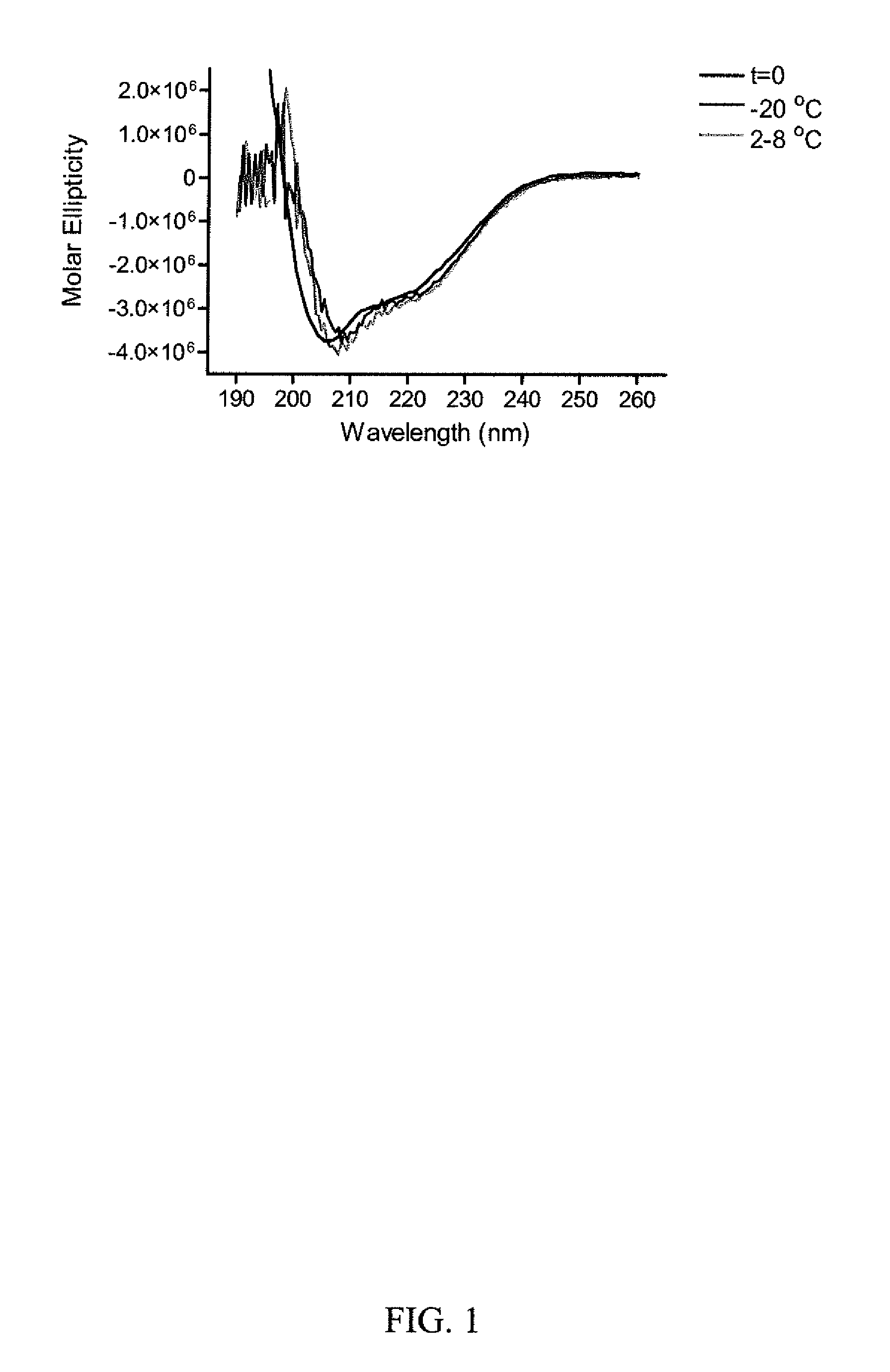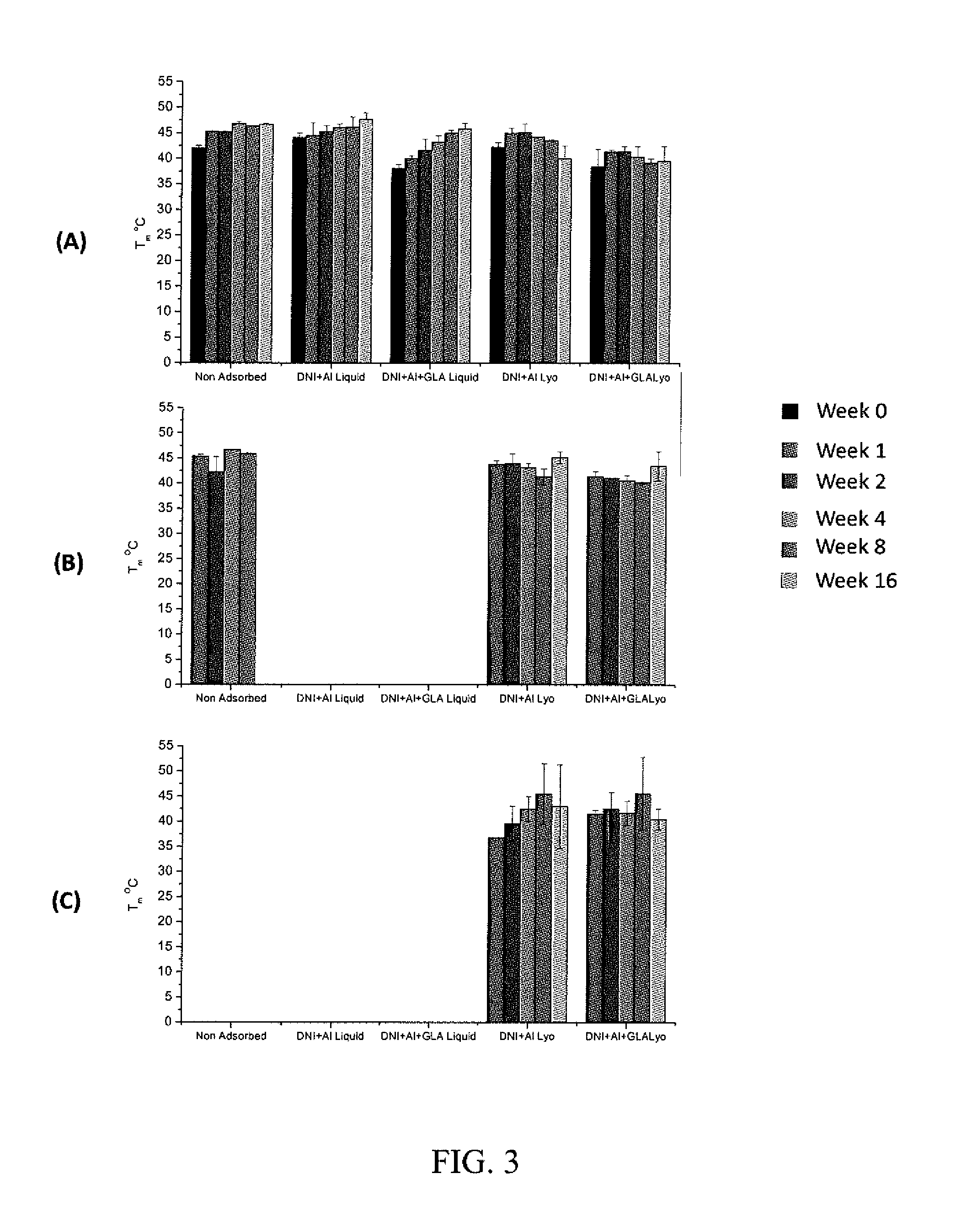Multivalent Stable Vaccine Composition and Methods of Making Same
a vaccine composition and multi-stable technology, applied in the field of stable immunogenic compositions, can solve the problems of affecting the simultaneous development of protective immunity, affecting the immune response, so as to achieve stable immunogenic composition and robust and durable immune response
- Summary
- Abstract
- Description
- Claims
- Application Information
AI Technical Summary
Benefits of technology
Problems solved by technology
Method used
Image
Examples
example i
Production of Vaccine Antigen Ricin A Chain
[0076]Ricin A chain is structurally unstable, with improvements being necessary to achieve the objective of long lasting and rapid onset immunity using 2 vaccine doses or fewer. The ricin A chain is extremely labile in aqueous buffers without stabilizers, leading to unfolding and aggregation of the protein in solution. Protein unfolding also occurs on the surface of aluminum adjuvant particles in the liquid suspension vaccines. The summation of the studies with liquid aluminum-adsorbed vaccine in mice, rabbits, humans and macaques indicate that improvements will be necessary to achieve the objective of long lasting and rapid onset immunity using two vaccine doses or fewer. Because the effectiveness of ricin A chain vaccine is thought to be associated with protein configuration, as the majority of neutralizing antibodies recognize conformational determinants, efforts were initiated to stabilize RiVax™ bound to conventional aluminum adjuvant ...
example ii
Assessment of RiVax™ Stability Over Time
[0086]A formal stability study was conducted over two years on RiVax™ protein from a former engineering run. The assay methodology and criteria for stability were based on the initial set of release specs established for the bulk protein during the first cGMP runs, Characterization tests have included generation of fluorescence spectra on the bulk protein, circular dichroism with thermal melt data, electrospray mass spectrometry, and N-terminal peptide sequencing. CD and fluorescence spectra are being more generally used for investigation into the process of monitoring protein configuration. The evaluation of stability was conducted at 2-4° C., 4° C., and 40°. For protein stored at −20° C. or 2-4° C., there is little evidence of structural change, or the appearance of alternate species over two years (Table 1). A double minima (208 and 222 nm) was observed in the CD spectra of the −20 and 2-8° C. stability samples buffer at all times tested up...
example iii
Stability of RiVax™ Adsorbed to Aluminum Hydroxide Adjuvant
[0088]Studies were initiated to monitor the tertiary structure of RiVax™ on the surface of Alhydrogel® using a fluorescence emission detection method that detects changes in tryptophan peak emission reflecting a change in the local environment of the residues from which water is excluded resulting in a red or blue shift indicative of a change in configuration in that region of the molecule.
[0089]Measurable fluorescence spectra can be detected in vaccine prepared with concentrations of RiVax™ in excess of approximately 50 μg / mL with 0.85 mgs of AlOH. Kinetics of the movement of the peak emission while the protein is adsorbed to Alhydrogel® can be determined using a front face triangular geometry cuvette system. This system is a method to monitor changes of protein configuration under a variety of conditions. For example, the following data have been generated for a reference batch of vaccine stored at 2-4° C. and 40° C. (FIG....
PUM
| Property | Measurement | Unit |
|---|---|---|
| particle size | aaaaa | aaaaa |
| mass ratio | aaaaa | aaaaa |
| mass ratio | aaaaa | aaaaa |
Abstract
Description
Claims
Application Information
 Login to View More
Login to View More - R&D
- Intellectual Property
- Life Sciences
- Materials
- Tech Scout
- Unparalleled Data Quality
- Higher Quality Content
- 60% Fewer Hallucinations
Browse by: Latest US Patents, China's latest patents, Technical Efficacy Thesaurus, Application Domain, Technology Topic, Popular Technical Reports.
© 2025 PatSnap. All rights reserved.Legal|Privacy policy|Modern Slavery Act Transparency Statement|Sitemap|About US| Contact US: help@patsnap.com



